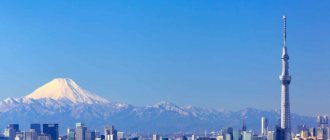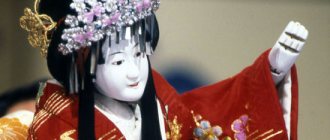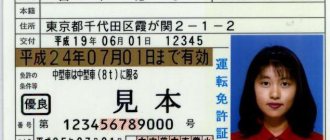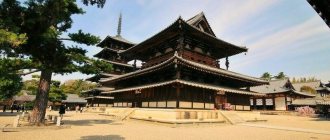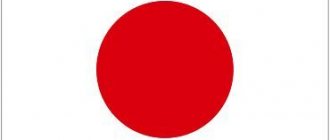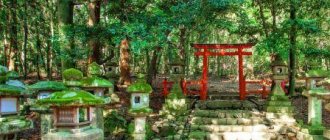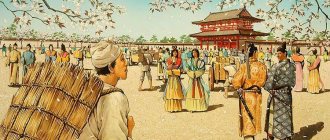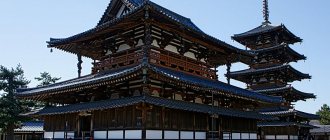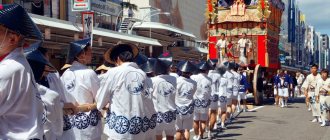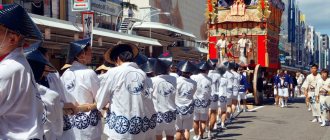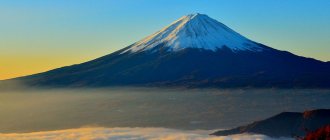Every country with an ancient history has its own city - a treasury where cultural and historical values have been accumulated for centuries, and sometimes for millennia. In Japan, Kyoto is rightfully considered such a pearl; its sights fascinate tourists, surprise and attract specialists. This city was the residence of the Emperor for more than a thousand years. Temples were built here, immortal works of literature and art were created. The most talented and ambitious individuals flocked here to shine in the glory of the great Emperor.
In Japan, it is a common expression that every Japanese should visit Fuji at least once, and they also say the same about the city of Kyoto - every Japanese should visit the ancient capital of Japan in their lifetime.
At a meeting with Japanese students, I decided to find out from Fujita-san how true the statement about Mount Fuji is and it turned out that not every resident of the Land of the Rising Sun has the opportunity to visit the sacred mountain, just like Kyoto. While you are young and full of energy, there are so many things to do in everyday life that there is no free time left. When there is time for a well-deserved rest, there is no strength to reach the top of the mountain or travel to the neighboring region.
Nevertheless, many residents of the country include in their life plans a visit to the first capitals of Japan, Nara and Kyoto. During the holidays, schools organize excursions to ancient capitals. Acquaintance with history and culture is an integral part of the educational process. And Kyoto has a collection of historical treasures like no other city in the country. There are a huge number of Shinto shrines and Buddhist temples, the imperial palace and the shogun's castle, a well-known rock garden (thanks to Vladimir Tsvetov) and many other attractions.
Imperial Palace
The main attraction of Kyoto is the Imperial Palace - Gosho. It was built in 795 for the fiftieth emperor of Japan - Kammu. 28 generations of emperors lived and served their people in the Kyoto Imperial Palace until 1868, when, during the Meiji Restoration, the residence of the emperors was moved to Edo (Tokyo).
The castle's current appearance was restored in 1854. During its existence, the imperial castle burned several times; at least 8 episodes of fire are known. At different times in history, a burnt castle was not restored for a long time due to lack of funds or due to civil strife that arose between clans. In the 16th-17th centuries, such outstanding Japanese warriors as Oda Nobunaga, Toyotomi Hideyoshi, and Ieyasu Tokugawa had a hand in restoring the imperial palace.
It is noteworthy that burnt castles, as a rule, were not restored, but a new one was built in a new location.
Kyoto Palace covers an area of more than 110,000 m², on its territory there are such buildings and complexes as: the throne room, the small Kogosho Palace, the Shunko Hall, the Sandai Hall, the Empress Hall, the Flower Hall and other ritual halls and utility rooms. All the gracefulness of the structure is emphasized by the palace park, on the territory of which pine trees, sakura, magnolias, maples and other vegetation grow.
Tourists can visit the Kyoto Imperial Palace only twice a year: in the first ten days of April and from the 20th of October. It is at this time that the territory of the imperial palace looks especially beautiful. At other times, the palace can be visited only with special permission.
During a visit, all movements of tourists are strictly regulated and a certain amount of time is given to get acquainted with the sights. Compliance with the rules is closely monitored by the security service of the imperial palace.
Short story
The extraordinary city of Kyoto is located on the island of Honshu. It was founded 794 , on the site of the village of Uda , as the main residence of Emperor Kammu . During the founding period, the territory of the modern city was called Heifn-kö . Translated, this name means “ capital of calm and peace .” After its construction, the city became not only the residence of the emperor, but also the center from which the leadership of the empire was carried out. Modern Kyoto has become not only the capital of a majestic empire, but also a cultural, political and business center. In 1467 , a war began on Japanese territory that lasted until 1477 , a period during which the city suffered greatly. For two centuries, attempts were made to restore the former power of the capital. Only towards the end of the 16th century, under Toyotomi Hideyoshi, the revival of the city began.
The city's prosperity continued after the capital was moved 1869 . Much attention was paid to the development of culture and education. Industry also developed rapidly, unlike other prefectures of the empire.
Nijo Castle
This is the former residence of the shoguns, which is a huge museum complex with an area of 275,000 m². A third of the territory of the castle complex is occupied by buildings.
The castle was built in 1603. Throughout time, the castle was a symbol of the emergence of a new influential shogun - Ieyasu Tokugawa.
Just like all the “wooden architecture” of Japan, Nijo Castle burned repeatedly during times of troubles and as a result of natural disasters. The last construction of the castle, after a lightning strike, took place in 1750.
The most famous attractions of the complex are the castles of Hommaru and Ninomaru. Ninomaru Castle was built on a grand scale to show the power and wealth of the shogun.
Its walls are made exclusively of cypress, the outer parts are richly decorated with sheets of gold and exquisite wood carvings. The sliding doors and walls of the rooms depict paintings by famous artists of that time.
A well-known feature of Ninomaru Castle is its singing floors; during construction, it was specially made so that when walking, the floors make a sound, thereby preventing anyone from entering the castle unnoticed, a kind of medieval alarm system.
From a historical point of view, Nijo Castle is significant because it was here in 1867 that the last shogun of Japan, Yoshinobu Togukawa, abdicated his power and returned state power to Emperor Meiji. Around this time, the castle became the property of the imperial family. In 1939, Nijo Castle was transferred to the ownership of the city municipality and turned into a museum open to the public.
Otowasan Kiyomizu-dera – Temple of Pure Water
It's not just foreign tourists who flock to this complex, located on a mountainside in the Higashiyama region. The Japanese come here suffering from unrequited love. On the territory of the temple there is an ancient shrine, where, according to legend, three spirits live. These include Okoninushi no Mikoto, the spirit of love. The Japanese are sure that if you ask him well, he will instill a reciprocal feeling in the object of passion. They come to pray at the stones of love.
Rivers flow inside the temple complex, forming a waterfall of the same name, or rather the temple is called Kiyomizu Falls, which means clean water.
The attractions of the complex are such structures as: the Nio Gate, the bell tower, the amazing three-tier pagoda and the Kiyomizu-dera temple itself (Kiyomizu-dera)
The temple was founded in 778, but today's building dates back to 1633, and not a single nail was used in its construction. The main hall has a large veranda, very popular among tourists, with views of Kyoto from the terrace. The veranda is supported by large columns as high as a four-story building.
During the Edo period, the proverb “Jump off the stage at Kiyomizu” was born, which meant “Take a decisive step”; sources indicate that this was not just a catchphrase. During the period from 1694 to 1864, 234 jumps from the temple veranda were recorded, and 34 people died. The survival rate was 85% and this is attributed to the fact that at that time, the soil under the slope was soft and a large number of trees increased the percentage of a favorable outcome.
The reason for such unusual jumps was not at all the desire to commit suicide; people surrendered themselves to the power of the goddess Kannon, to whom pilgrimages were organized with prayers for health. Among the people who made the jumps were children under 12 years old, women, and those who made the jump twice. Most of the desperate jumpers were under the age of 20 and nothing else but recklessness comes to mind to explain the reason for the jump.
In 1872, a ban on jumping was introduced and attempts to “jump off the stage in Kiyomizu” began to be suppressed.
The complex is a stunning sight and is, in one version, the “seventh wonder of the world.”
Population and religion
The ethnic composition of Ecuador is 65% mestizo, 25% Indian, 7% Spanish and 3% black. But it is worth noting that almost all residents of the country consider themselves Spaniards.
As for Quito, according to the census conducted in 2005, the capital of Ecuador has a population of 1,856,501. This city is the second largest in the country in terms of population. In first place is the city of Santiago de Guayaquil.
The population of the capital is represented by various nationalities. So, two-fifths of it are Quechua Indians. There are just as many Spanish-Indian mestizos in the city. One fifth of the total population are blacks, and only a small proportion come from Asian and European countries.
4% of Quito's population is illiterate. The main religions in the city are Christianity and Catholicism.
People who come to Ecuador for the first time note that the locals are very similar to the Italians, Portuguese and Spaniards. They are also welcoming, friendly and smiling. Travelers also note that they are disorganized and unnecessary. People in Ecuador love to promise and not keep their words. Sometimes you can get what you want from the residents of a country only if you give a decent reward for it. However, for the most part, Ecuadorians are proud people. Many of them simply don't pay attention to money. And besides, the desire to earn extra money, as a rule, overcomes laziness.
Kinkaku-ji - Golden Pavilion
The three-story magnificent building is part of the Rokoun-ji complex. It is located on the shores of the cleanest Lake Kyokoti. The temple is famous for the fact that its walls outside and inside (on the upper floors) are covered with real gold. The traditional roof is decorated with a phoenix made of the same precious material.
The pavilion was built in 1397. Then it was built as a villa for the shogun Ashikaga Yoshimitsu. He loved this beautiful place very much, often visiting it to admire the reflection of the “precious” pavilion in the clearest waters. Nowadays the building is used as a shariden, that is, a repository of Buddha relics.
The history of the golden pavilion is amazing - having survived the destructive wars of the time of troubles, it was completely destroyed in peacetime by a 22-year-old novice monk who set fire to it on July 2, 1950.
Today's magnificent building dates back to 1955, when reconstruction of the Golden Pavilion began. The height of the pavilion is 12.5 meters.
The new building is as close as possible to the original. In Japanese philosophy, no matter that the building was destroyed, burned and rebuilt, it is still considered original, since regardless of new building materials, this pavilion (temple) will always remain the same as it was originally.
There is a garden around the pavilion that has been growing here since the 14th century. Despite the fact that the lake - a mirror (as its name is translated) is deep, here and there miniature islands - stones - protrude on its surface. Many have centuries-old pine trees. Stones and islands are positioned in the water in such a way that they frame the precious reflection. This creates an atmosphere of solemnity and sophistication throughout the complex.
For a long time, the pine trees in front of the pavilion have been shaped like a sailing ship.
In the fall of 2021, I visited the Golden Pavilion and, dare I say it, “contemplated” its beauty and grandeur. You can talk as much as you like about the unique temple, but the reality exceeds all expectations. Read the photo report about Kinkaku-ji Temple in the article The most beautiful temple in Kyoto.
Rock garden
The famous Ryoanji Garden is located on the grounds of Ryoan-ji Temple, located in the Ukyo district. This is a very special building. A small area (30 x 10 meters) is covered with white gravel. There are fifteen untreated black stones on it. The entire site is fenced with an adobe wall.
The peculiarity of the garden is that it is impossible to see all the dark stones at the same time, no matter from which point the viewer looks. The latter will always remain out of his sight. Here is how V. Tsvetov writes:
…I said “fifteen stones” because that’s what the guidebook says. In fact, you only notice fourteen. The fifteenth stone is not before my eyes. It is blocked by neighbors. You take a step along the wooden gallery stretching along the edge of the sandy rectangle - on the other three sides the garden is bounded by stone monastery walls - and again there are fourteen stones. The fifteenth one, the one that had been hiding until now, was now among them, and the other stone disappeared. One more step along the gallery, and the ingeniously planned chaos appears again in a different composition, consisting of the same fifteen stones, one of which is invisible.”
The philosophical meaning of the dry garden, as Ryoanji is also called, is that only a person who has achieved enlightenment “sees everything.” To view the entire landscape, you need to soar above the magical garden. And such mastery is achieved only by a person with a soul unburdened by sins.
Another attraction of Ryoan-ji Temple is the Stone Vessel. Translated, its name means “temple of the resting dragon.” People who thirst for spiritual cleansing come here. After going around the temple, they can take a bath or drink from a stone bowl into which clean water constantly flows.
It is built in such a way that a person bends towards the life-giving moisture. This is a way to show your respect to this place. The bowl is decorated with an inscription containing the main idea of Buddhist teachings. It reads:
What everyone has is all they need.
Agree, it’s time for our world, immersed in the struggle for money and power, to remember this simple truth.
Rock garden through my eyes.
Sagano Bamboo Forest
On the Internet, when searching for “beautiful places on the planet,” you often come across photographs of a bamboo forest - slender, smooth rows of tall trees that cannot leave a single person indifferent. Even more emotional is a visit to this place advertised on the Internet - the Sagano bamboo forest , sandwiched by the urban quarters of Kyoto in a small area (only 16 km2). Thousands of trees swaying in the wind produce a pleasant sound, reminiscent of the melody of windy bells, widespread in the East. The Japanese claim that this melody produces a calming effect, creating comfort in the soul and returning the body to natural harmony with nature.
The protected grove of Sagano dates back to the 14th century, when the park was created under the leadership of the monk Muso Soseki. The highlight of the landscape creation was the observation deck, from which an amazing view of the mountains and temples of the surrounding area opened and still opens. It is noteworthy that bamboo never grew on the Japanese islands - it was brought from China. The plant is distinguished not only by its smooth, tall trunk, but also by its impressive growth rate - more than 20 meters per month.
Fushimi Inari Taisha
There are many temples and shrines in Japan. One of the most famous and beautiful is Fushimi Inari, located on Inariyama Hill. To look at it you will have to climb many steps and travel for two hours, but the beauty that reveals itself to the gaze of the tourist is worth it.
This temple is dedicated to Inari, the goddess of rice. The constant companions of the goddess are foxes - kitsune. Legends say that it was foxes that helped Inari protect rice supplies from rodents. There are statues of foxes everywhere on the temple grounds. In Japan, they believe that this animal is Inari's messenger on earth. The statues are depicted with barn keys in their teeth or with an ear of rice.
Fushimi Inari is a place that brings wealth. People come to the temple to pray for prosperity and ask for prosperity for their family or company. To do this, they buy tablets in the form of ritual gates (torii) and write wishes on them.
For the prosperity of the company, its leaders are ready to donate real torii to the temple, which cost a lot of money, but nevertheless there are a large number of people willing to donate. In the temple complex you can walk through a tunnel of orderly lined torii. In order for the year to be prosperous, it is necessary to walk along the corridor of the “red gate” on New Year’s Day.
The temple is especially beautiful at dawn; the bright colors of the temple in the rays of the rising sun make an indelible impression.
In the fall of 2021, I had the opportunity to see the temple complex at night. It was an interesting experience. Fushimi Inari is beautiful at any time of the day.
Sights of Kyoto
What to see in Kyoto? Lots and lots of things! The abundance of temples and sanctuaries in ancient Kyoto will make your head spin on the second day. The easiest way is to outline a rough plan for the day consisting of 3-4 sights of Kyoto, and just walk between them, absorbing everything new and unusual that will await you in the cultural capital of Japan.
Sights and places of interest in Kyoto are scattered throughout the city and around it. It’s easier to map out the route geographically: today – Gion + eastern Kyoto. And tomorrow - Kinkakuji Golden Pavilion + Ryoanji Rock Garden + the oldest teahouse in Japan. And so on.
Some come to Kyoto for just a couple of days. In such a time there is little time to see. It's better if you have a few days in Kyoto. The sights of Kyoto described below were visited by us in 5 days at a rather intense pace. If you are used to a more relaxed schedule, you can see these places in Kyoto in a week.
Gion Quarter in Kyoto
The first thing tourists try to see in Kyoto is the Gion quarter, the heart of the city. It is said that among the ancient wooden tea houses on the curved streets you can meet a geisha. In fact, in almost all tourist reviews about Kyoto, the photographs show not geishas, but tourists from Asian countries - Thai and Chinese
